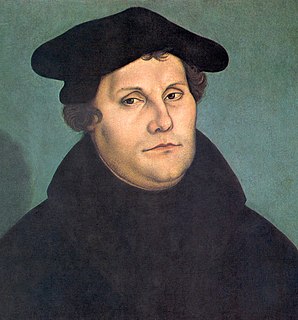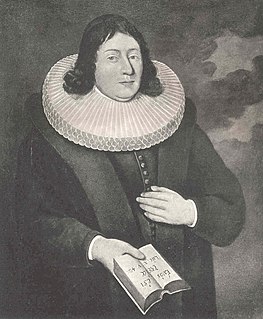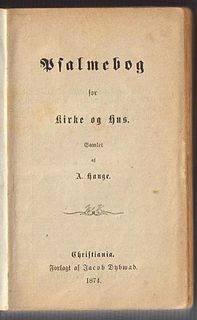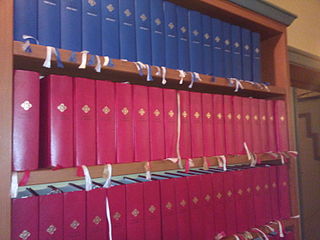Landstads kirkesalmebog (Landstad's Church Hymnal), often simply known as Landstads salmebok (Landstad's Hymnal), was the most important hymnal for the Church of Norway from 1870 to 1926.

The Church of Norway is an evangelical Lutheran denomination of Protestant Christianity and by far the largest Christian church in Norway, with membership mandatory for everyone until the 19th century.
In 1852, Magnus Brostrup Landstad (1802–1880) started compiling a new church hymnal. [1] At that time, three different hymnals were in use: Kingo's hymnal from 1699, Guldberg's hymnal from 1778, and Evangelisk-christelig Psalmebog (Lutheran-Christian Hymnal) from 1798. All three were therefore Danish and did not satisfy the Church's needs.

Magnus Brostrup Landstad was a Norwegian parish priest and provost, psalmist and poet who published the first collection of authentic Norwegian traditional ballads in 1853.

Kingo's hymnal, officially titled Dend Forordnede Ny Kirke-Psalme-Bog, is a hymnal that was approved by royal decree for use in all churches in Denmark–Norway in 1699. The contains 86 hymns by the bishop of Odense, Thomas Kingo. It also bears Kingo's name on the title page because the selection was made based on a hymnal that Kingo had edited ten years earlier.

Guldberg's hymnal is a hymnal that was created by Bishop Ludvig Harboe and Ove Høegh-Guldberg and was authorized for use in 1778.
In 1855, Landstad published a sample of his translations of Luther's hymns, and in 1856 he published a volume with Christmas hymns. In 1861 he presented his draft new hymnal with 640 hymns arranged in verse form. [1] The draft was sharply criticized because of its use of dialect vocabulary; the bishop and hymnologist Johannes Skaar argued that Landstad had mixed peasant language and cultured language. [1] Landstad replied to the criticism in his book Om Salmebogen, en Redegjørelse (A Statement Regarding the Hymnal, 1862). He made some changes based on the criticism. In 1865 a public committee met to decide on the draft. The hymnal was approved under a royal resolution of October 16, 1869 [1] and it was printed in 1870 [2] and could then be used in parishes that decided to adopt it.

Martin Luther, was a German professor of theology, composer, priest, monk, and a seminal figure in the Protestant Reformation.

Johannes Nilsson Skaar was a Norwegian bishop and hymnologist.
The hymnal had 634 hymns, of which 307 were originally Danish hymns, 203 were German, and 86 were Norwegian. Landstad himself wrote 60 original hymns. [1] In addition, it contained many of his translations. An innovation in the Norwegian context was hymns that were translated from Swedish. One example is "Den blomstertid nu kommer" (Now the Time of Blossoming Arrives), credited to Israel Kolmodin.

Den blomstertid nu kommer is a Swedish summertime hymn, traditionally credited to Israel Kolmodin after walking at Hångers källa outside Visby. The origin of the hymn is, however, debated. It was first published in the 1695 Swedish Hymnal.
Israel Gustaf Kolmodin was a Swedish hymnwriter and Lutheran priest, active in the Church of Sweden. He is usually credited for having written the song "Den blomstertid nu kommer."
On March 4, 1892, Elias Blix's Nokre salmar (Some Hymns) was authorized for use in public worship, and these Landsmål hymns were then incorporated into Landstad's hymnal as nos. 635–791.

Nokre salmar was the first Nynorsk hymnal. It was published anonymously by Elias Blix. The volume was first issued as smaller booklets, with the first in 1869, and then in 1870 and 1875, and then in an expanded version in 1883 published by Det Norske Samlaget. On March 4, 1892 Nokre Salmar was authorized for use in public worship, and these Landsmål hymns were then incorporated into Landstad's hymnal as nos. 635 to 791.
Landstad's hymnal was revised by the diocesan provost Gustav Jensen and a committee. [3] [4] Landstads reviderte salmebok (Landstad's Revised Hymnal) was approved under royal resolutions of October 8, 1920 [5] and February 15, 1924, and it was published in 1926. [6]

Gustav Margerth Jensen was a Norwegian priest, hymnologist, hymnwriter, seminary instructor, and liturgist. He is best known for his liturgy revision and hymnal publication.
Landstads reviderte salmebok was a hymnal authorized for public worship in Norway under the royal resolutions of October 9, 1920 and February 15, 1924. The book was the Church of Norway's official hymnal until 1985, together with Nynorsk salmebok.







